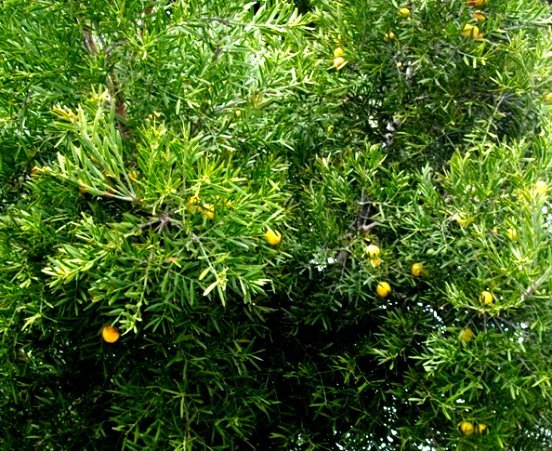Afrocarpus falcatus

Author: Ivan Lätti
Photographer: Ivan Lätti
Afrocarpus falcatus, commonly the small-leaved yellowwood or in Afrikaans the kalander or Outeniqua-geelhout and previously botanically Podocarpus falcatus, is a medium-sized to large tree of heights between 20 m and 60 m (SA Tree List No. 16). The kalander name followed an earlier name, Outeniekwalander (Outeniqua dweller or citizen), as a colloquially shortened form. The kalanders become the tallest trees of their forest.
This yellowwood is shown bearing its deep yellow equivalents of fruits among the leaves. Being a Gymnosperm or conifer, not an Angiosperm or flowering tree (of which there are probably 300 000 on earth), the yellow spheres are the seeds produced only by a female tree, the species being dioecious.
The seed cones grow from leaf axils, as do the male cones from leaf axils on their separate trees, but smaller, about 10 mm by 3 mm. Clouds of winged pollen grains can at times be driven by wind, the only pollinator, from the male tree. On the female tree the fleshy seeds, about 1,5 cm in diameter and deep yellow when ripe, are developed from the female cones. These female cones consist of tiny, fleshy scales. Cones are initially only slightly expanded at the tips of woody stalks. The single ovules in them are naked and the receptacles not fleshy. The seeds take about a year to develop on the tree, almost ensuring that there will be some of them in one or other stage of development to be seen at all times during the tree's life.
The species distribution is in a broad, coastal swathe from the Western and Eastern Cape to KwaZulu-Natal and inland to the Mpumalanga and Limpopo Lowveld. The distribution continues into Mozambique and other countries to the north in tropical Africa.
The habitat is tall, moist forests and swamp forests, also in drier wooded ravines and montane forest where the trees are shorter. The habitat population is deemed of least concern early in the twenty first century.
The famous Big Tree of the Knysna Forest belongs to this species (Venter, 2012; Coates Palgrave, 2002; Schmidt, et al, 2002; iNaturalist; Wikipedia; http://redlist.sanbi.org).

